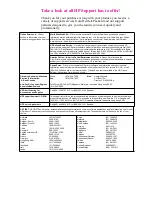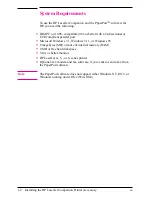
Copyright Information
© 1996 Hewlett-Packard
Company
All Rights Reserved.
Reproduction, adaptation, or
translation without prior written
permission is prohibited, except
as allowed under the copyright
laws.
Part number: C3989-90902
First Edition, March 1997
Warranty
The information contained in
this document is subject to
change without notice.
Hewlett-Packard makes no
warranty of any kind with regard
to this material, including, but
not limited to, the implied
warranties of merchantability
and fitness for a particular
purpose.
Hewlett-Packard shall not be
liable for errors contained herein
or for incidental or consequential
damages in connection with the
furnishing, performance, or use
of this material.
NOTE TO U.S.
GOVERNMENT USERS:
RESTRICTED RIGHTS
COMMERCIAL COMPUTER
SOFTWARE: “Use, duplication
or disclosure by the Government
is subject to restrictions as set
forth in subparagraph (c) (1) (ii)
of the Rights in Technical Data
Clause at DFARS 52.227-7013.”
Material scanned by this product
may be protected by
governmental laws and other
regulations, such as copyright
laws. The customer is solely
responsible for complying with
all such laws and regulations.
Trademark Credits
PaperPort
™
is a trademark of
Visioneer, Inc. in the United
States and other countries.
Microsoft®, Windows®, and
MS-DOS® are U.S. registered
trademarks of Microsoft
Corporation. Lotus® and Lotus®
1-2-3® are U.S. registered
trademarks of Lotus
Corporation. Adobe
Photoshop™ is a trademark of
Adobe Systems, Inc., which may
be registered in certain
jurisdictions. All other products
mentioned herein may be
trademarks of their respective
companies.
FCC Regulations
This equipment has been tested
and found to comply with the
limits for a Class B digital
device, pursuant to Part 15 of the
FCC rules. These limits are
designed to provide reasonable
protection against harmful
interference in a residential
installation. This equipment
generates, uses, and can radiate
radio frequency energy, and if
not installed and used in
accordance with the instructions,
may cause harmful interference
to radio communications.
However, there is no guarantee
that interference will not occur
in a particular installation. If this
equipment does cause harmful
interference to radio or television
reception, which can be
determined by turning the
equipment off and on, the user is
encouraged to try to correct the
interference by one or more of
the following measures:
• Reorient or relocate the
receiving antenna.
• Increase separation between
equipment and receiver.
• Connect equipment to an outlet
on a circuit different from that to
which the receiver is connected.
• Consult your dealer or an
experienced radio/TV technician.
Note: Any changes or
modifications to the device not
expressly approved by HP could
void the user’s authority to
operate this equipment.
Use of a shielded interface
cable is required to comply
with the Class B limits of Part
15 of FCC rules.






































